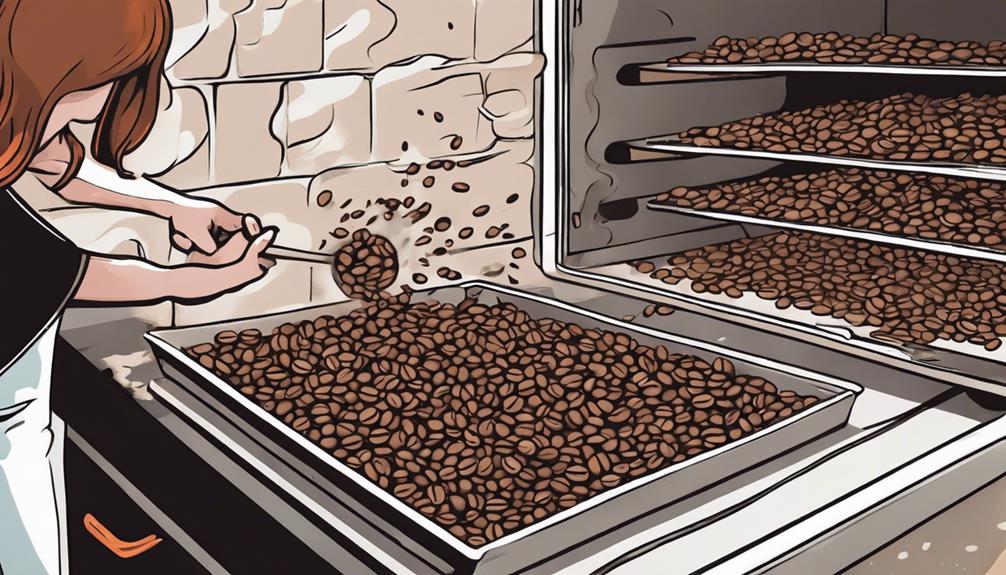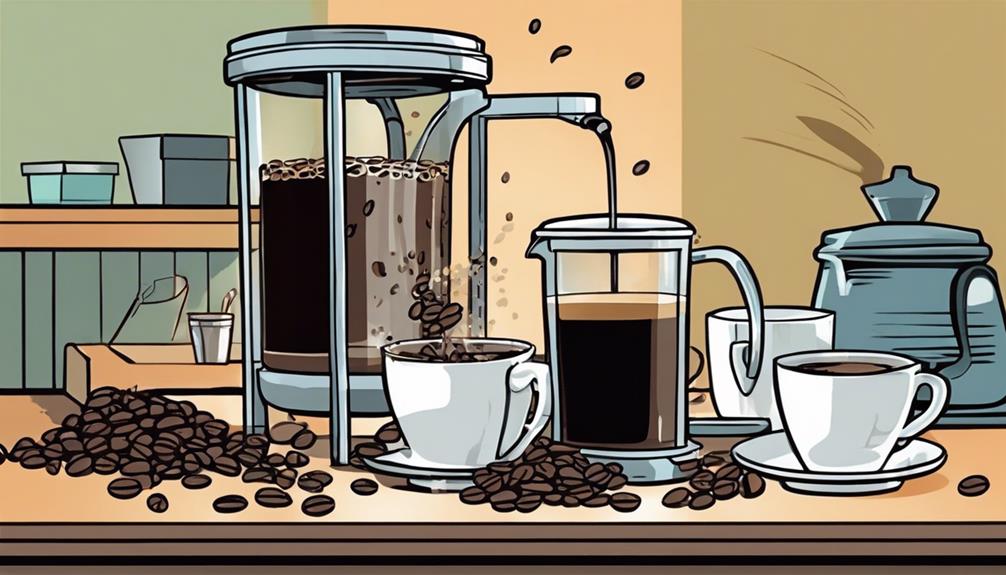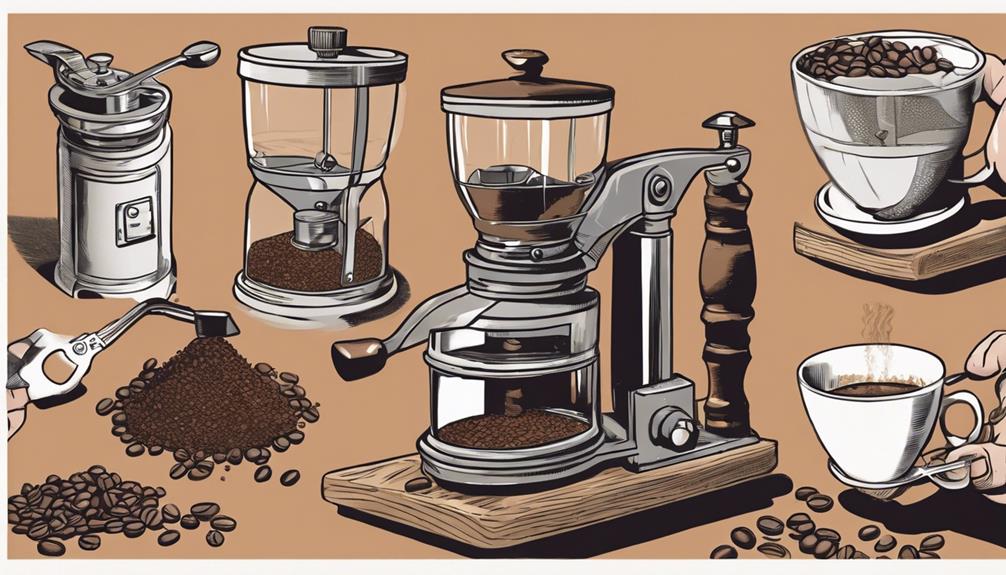Roast your coffee beans to elevate their flavor! Uncover a depth of rich tastes through roasting, creating a truly fragrant brew. Try out different infusion methods and spice-oil blends. Enhance the flavor profile of your coffee and customize it to your liking. Dive into international coffee flavors and learn about the effects of various additives. Prolong the freshness of your brew with proper storage. Also, consider using commercial flavor enhancers for an added burst of taste. Take your coffee up a notch by roasting those beans and savor a symphony of flavors with every sip. To truly enhance your coffee experience, invest time in understanding the process of grinding coffee beans and resetting the aroma. Experiment with different grind sizes and adjust the water-to-coffee ratio to further intensify the flavors and aromas in your brew. Don’t hesitate to get creative with your coffee-making routine and explore novel techniques to bring out the best in your beans and the aroma reset. In the end, the satisfaction of a flawlessly brewed cup of coffee is well worth the time and dedication you put into perfecting your craft.
Key Takeaways
- Experiment with pre-roasting spice infusions for complex flavors.
- Use natural additives like vanilla extract or ground cinnamon.
- Ensure proper storage in a cool, dark place for freshness.
- Post-roasting flavor additions offer control over infusion process.
- Commercial flavor enhancers can be used for convenient flavoring.
Infusion Techniques for Enhanced Flavor
To enhance the taste of coffee beans, consider experimenting with infusion techniques. Flavoring your coffee through infusion opens up a world of possibilities. By incorporating flavor additives like liquor, syrups, spices, oils, or extracts, you can create a unique and personalized coffee experience.
Pre-roasting infusion methods involve soaking beans in liquids like liquor or flavored syrups, while post-roasting techniques entail adding spices, oils, or extracts to roasted beans. These infusion methods not only enhance the taste of your coffee but also allow you to tailor the flavor to your preferences.
By exploring different infusion techniques, you can discover new and exciting flavor profiles that can elevate your coffee brewing experience. Experimentation with infusion can lead to a deeper understanding of how various flavors interact with coffee beans, influencing brewing methods, grinding requirements, and ultimately enhancing your overall coffee enjoyment.
Flavoring your coffee through infusion is a creative and rewarding way to elevate your coffee game.
Spice and Oil Flavoring Methods
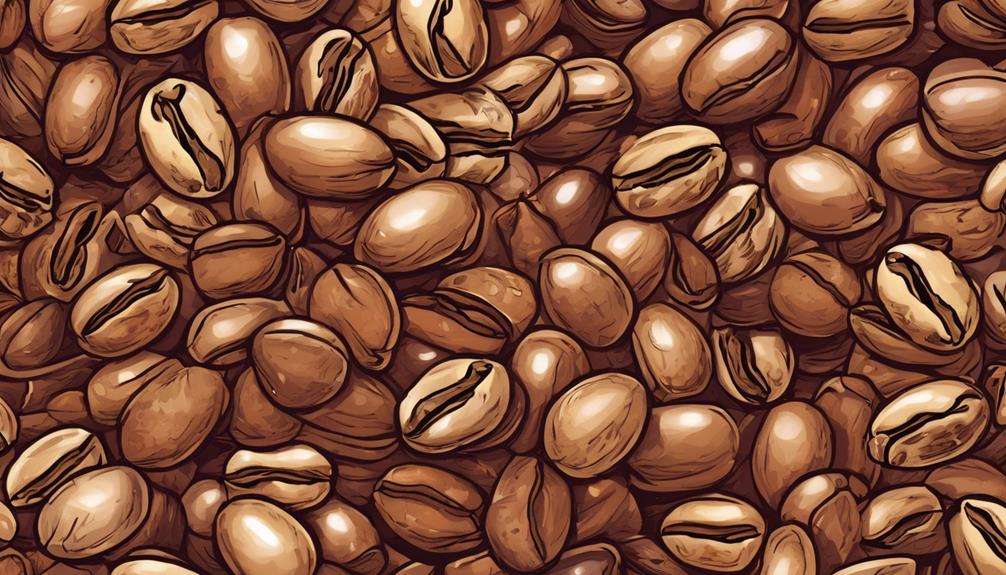
You can elevate the taste of your coffee beans by exploring spice infusion techniques and oil flavoring options. Experiment with adding spices like cinnamon, nutmeg, or clove, and consider using oils such as mint, mocha, or vanilla for rich flavors.
Remember to maintain the right balance by following the 3% rule for flavor concentration levels.
Spice Infusion Techniques
Enhance the taste of your coffee beans by utilizing spice infusion techniques, incorporating spices like cinnamon, nutmeg, clove, and cardamom. These spices can be combined with flavoring oils such as mint, mocha, and vanilla to create unique and aromatic blends.
When using spice infusion techniques, remember the 3% rule: add 3% of flavoring to the total weight of coffee beans for best outcomes. By infusing your beans with a variety of spices and oils, you can customize your coffee blends to suit your preferences.
Experimentation is key when it comes to spice and oil flavoring methods. Try different combinations to discover your favorite flavor profiles. This versatile approach allows you to get creative and craft personalized coffee blends right in your own kitchen.
Whether you prefer a hint of cinnamon or a touch of vanilla, spice infusion techniques offer a world of possibilities for elevating the taste of your coffee beans.
Oil Flavoring Options
Oil flavoring options, such as mint, mocha, and vanilla, can enhance the taste of coffee beans by infusing complementary flavors. When considering oil flavorings for your coffee beans, keep in mind the following:
- Versatility: Oils like mint, mocha, and vanilla offer a wide range of flavor profiles that can cater to various preferences.
- Intensity Control: Adjust the amount of oil used during the flavoring process to control the intensity of the infused flavors in the coffee beans.
- Experimentation: Don't be afraid to experiment with different oil combinations to discover unique and delicious coffee blends tailored to your liking.
Using oils for infusing coffee beans can bring out new dimensions of taste and aroma, providing a delightful experience for coffee enthusiasts.
Whether you prefer a subtle hint of mint or a rich mocha undertone, oil flavoring offers a customizable way to elevate your coffee brewing game.
Flavor Concentration Levels
Spice and oil flavoring methods play a pivotal role in determining the best concentration levels of flavors infused into coffee beans. When flavoring coffee beans, the use of spices such as cinnamon, nutmeg, and clove can add depth and richness to the beans.
Similarly, incorporating oils like mint, vanilla, or mocha can provide a range of complementary flavors. The 3% rule suggests that adding 3% of flavor to the total weight of coffee beans can achieve prime flavor concentration without overpowering the natural coffee taste.
Experimenting with different spice and oil combinations allows for the creation of unique and enjoyable flavor profiles in flavored beans. Proper infusion techniques are essential as they significantly influence the overall taste and aroma of the brewed coffee.
Impact of Flavors in Coffee Industry
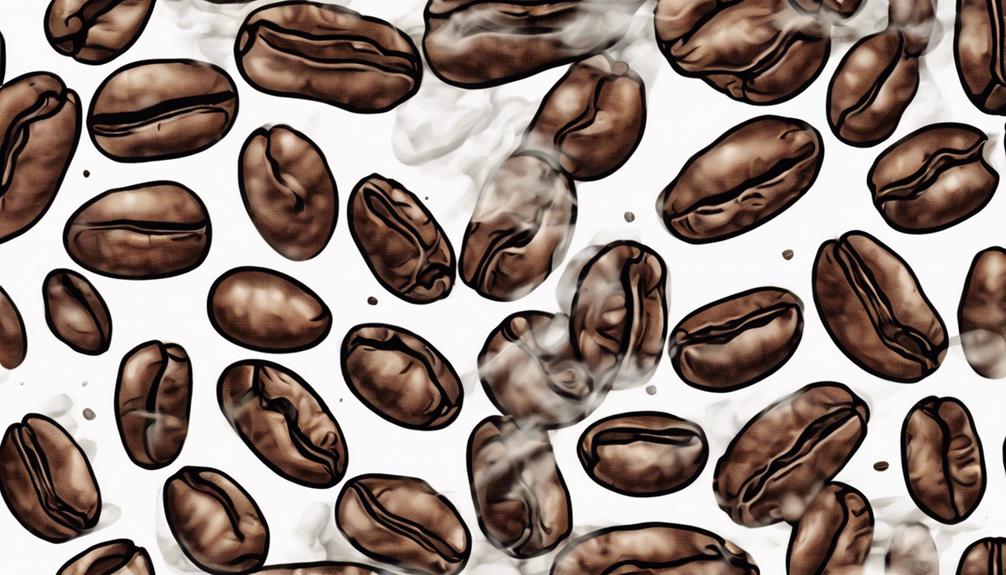
Let's talk about how flavors are shaping the coffee industry, impacting trends, ethics, and transparency. Industry players are riding the wave of innovative flavor profiles, but questions around ethical sourcing and transparent labeling are surfacing.
Understanding the influence of flavors in coffee is key to steering through this ever-evolving landscape.
Industry Flavor Trends
Enhancing coffee flavors through the use of various additives has become a prevalent trend in the coffee industry, influencing the overall taste experience for consumers and industry professionals alike.
When looking at industry flavor trends, consider the following:
- Flavoring Coffee: Many coffee producers are experimenting with flavored coffee to cater to diverse consumer preferences. Whether it's vanilla-infused beans or caramel notes, these additional flavors can create unique and enticing coffee profiles.
- Transparent Practices: The industry is increasingly emphasizing the importance of transparency regarding flavor additives. Undisclosed flavorings can lead to trust issues among consumers and impact the reputation of coffee brands.
- Competition Concerns: While flavored coffee can be popular among general consumers, it may face scrutiny in competitions and grading processes. Critics argue that additional flavors can mask the true quality and characteristics of the coffee beans.
As the coffee industry continues to evolve, staying informed about these flavor trends can help both professionals and enthusiasts navigate the complex world of coffee flavors.
Ethical Flavor Considerations
Considering ethical implications in flavoring coffee beans involves ensuring transparency and honesty regarding any additives used in the coffee industry. When flavoring beans, it's pivotal to disclose all ingredients, especially if vanilla or other flavors are added.
Undisclosed flavoring can distort the natural essence of coffee and affect how it's perceived in the industry. Criticisms often arise in competitions and grading processes when hidden flavors are detected, impacting the integrity of the coffee industry.
Personal ethical standards may differ from general industry practices, making it essential to carefully consider the consequences of flavoring choices. By understanding the implications of flavoring coffee beans, you can navigate ethical dilemmas more effectively and make informed decisions that align with your values.
Transparency and honesty are key in maintaining the authenticity and quality of the coffee beans, ensuring a fair and ethical approach to flavor enhancement.
Flavor Transparency Importance
Why do flavors play an significant role in the transparency of the coffee industry?
Flavors are essential for consumers to understand what they're tasting and to appreciate the natural essence of coffee beans.
Here are three key reasons why flavor transparency is crucial in the industry:
- Authenticity: Consumers expect the flavor of their coffee to come from the quality of the beans and the roasting process, not from added artificial flavors. When coffee is flavored artificially, it raises concerns about the authenticity of the product.
- Quality: Undisclosed flavor additives can mask the true taste of coffee beans, affecting the quality of the final product. This can mislead consumers and distort their perception of what good coffee should taste like.
- Trust: Transparency in flavors builds trust between coffee producers and consumers. When the origin and natural flavors of coffee beans are clearly communicated, consumers can make informed decisions and trust the product they're purchasing.
Global Coffee Flavor Varieties
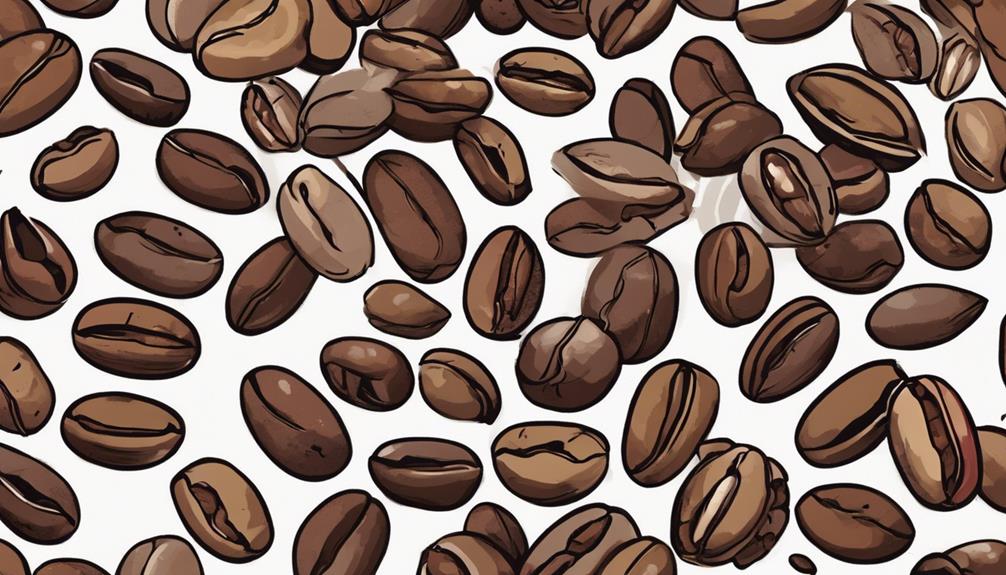
Global coffee flavor varieties offer a diverse range of aromatic and spicy blends that showcase unique cultural influences. Senegalese coffee combines cloves and Guinea pepper for a spicy and aromatic flavor.
Moroccan coffee stands out with cinnamon, cardamom, and nutmeg, creating a warm taste. Arab countries use saffron, ginger, and cardamom for a rich flavor experience.
Yemeni coffee features hawaij, a spice blend of cardamom, cloves, and cinnamon for a complex brew. Mexican caf de olla brews with cinnamon sticks, adding a sweet and spicy twist to traditional flavors.
Each of these varieties brings a distinct taste profile to the coffee experience, reflecting the diverse culinary traditions around the world.
Benefits of Infusing Coffee Beans
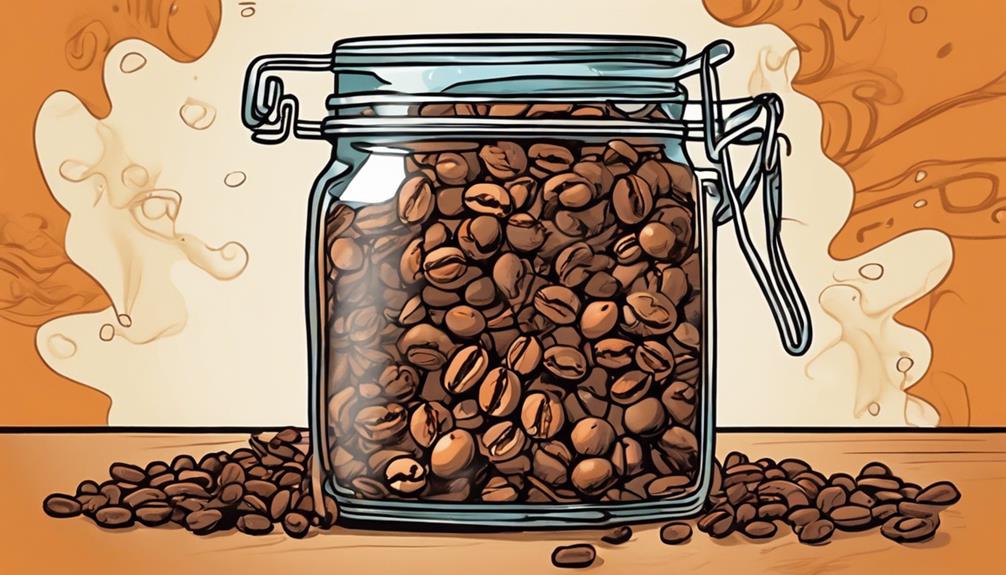
To further enhance your coffee experience, exploring the benefits of infusing coffee beans opens up a world of aromatic possibilities. When you infuse roasted coffee beans, you discover a domain of creativity and flavor combinations that can elevate your daily brew to new heights.
Here are three key advantages of infusing coffee beans:
- Enhanced Aroma and Taste: Infusing your beans with different flavors like vanilla, cinnamon, or even citrus can create a unique sensory experience that tantalizes your taste buds and invigorates your senses.
- Reduced Need for Additives: By infusing your coffee beans with natural flavors, you may find that you need less sugar or cream to achieve the desired taste profile, leading to a healthier and more authentic coffee drinking experience.
- Customized Flavor Profiles: Experimenting with bean flavoring allows you to tailor your coffee to your preferences, whether you enjoy bold and spicy notes or prefer a subtle hint of sweetness in your cup.
Effective Flavoring Techniques
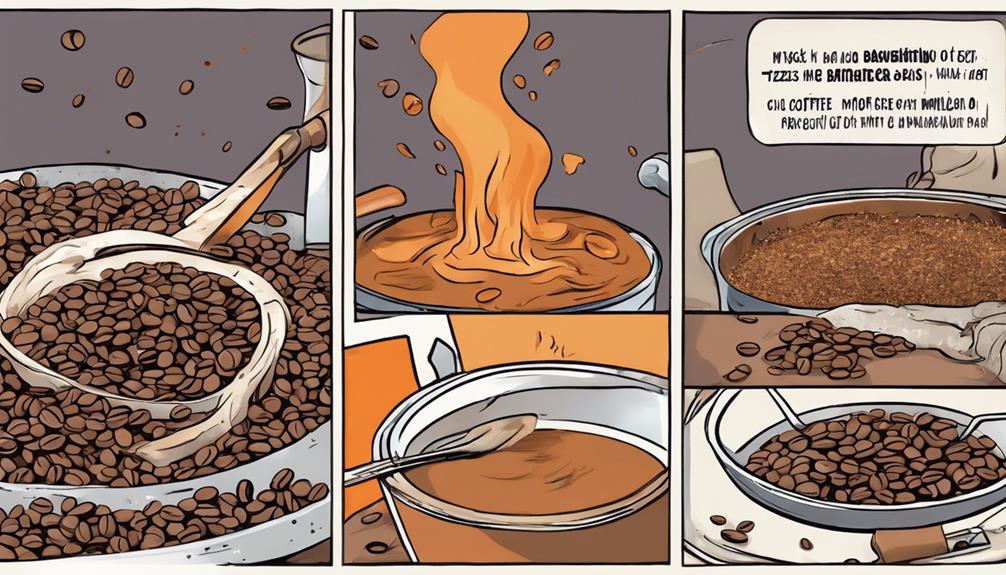
Using various methods, you can effectively infuse coffee beans with flavors to enhance the taste and aroma of your brew. Post-roasting flavor addition is a popular technique where flavors like vanilla, spices, or oils are introduced to the beans after the roasting process. This method allows for greater control over the infusion process, resulting in a more pronounced and customized flavor profile.
Experimenting with different flavoring oils can also yield exciting results. By carefully selecting high-quality oils such as hazelnut, coconut, or cinnamon, you can add depth and complexity to your coffee beans. These oils can be applied in precise amounts to achieve the desired flavor intensity without overpowering the natural coffee taste.
Remember that effective flavoring techniques can influence the brewing process and grinding requirements. The infusion of flavors may alter the beans' density, impacting the grind size and extraction time.
Additionally, proper storage of flavored beans is essential to retain freshness and preserve the infused flavors for a delightful coffee experience.
Natural Flavoring Options
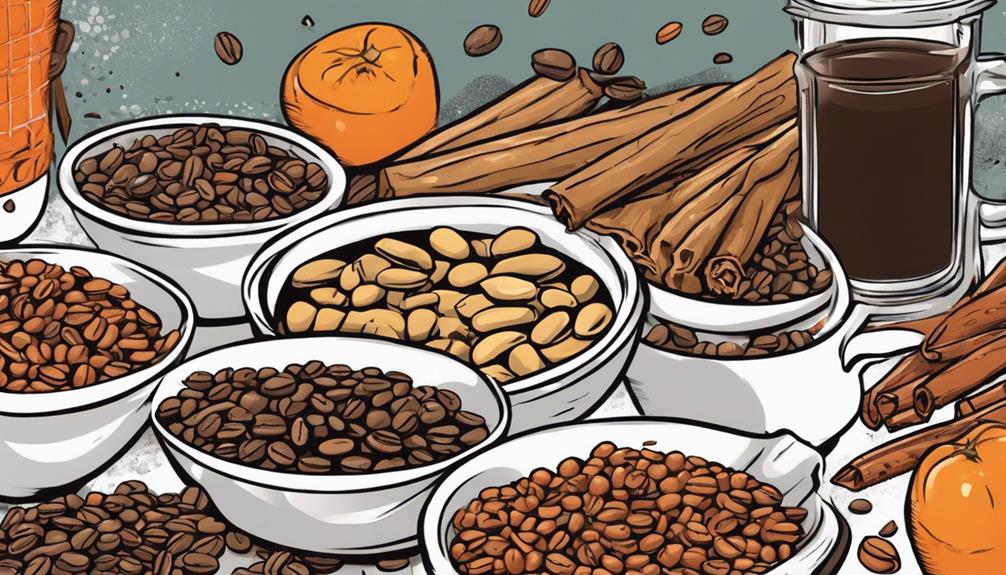
For enhancing the taste of your coffee beans, explore natural flavoring options such as essential oils, spices, and ingredients like vanilla extract and rum. Adding natural flavors to your coffee beans can elevate your brewing experience to new heights.
Here are some options to contemplate:
- Vanilla Extract: Infusing your coffee beans with homemade vanilla extract, crafted from vanilla pods and rum, can provide a rich and aromatic flavor profile.
- Ground Cinnamon: Sprinkling a dash of ground cinnamon onto your coffee beans before baking can add a warm and spicy note to your brew.
- Essential Oils: Experimenting with essential oils like citrus or lavender can offer unique and invigorating undertones to your coffee beans.
Shelf Life and Storage Considerations

Proper storage methods play a vital role in maintaining the improved taste of baked coffee beans. To prolong the shelf life of your baked beans and prevent flavor degradation, store them in an air-tight container. Airtight containers act as a barrier against moisture and light, shielding the beans from elements that could compromise their flavor. Ideally, keep the container in a cool, dark place to further preserve the freshness of the beans.
Allow the baked coffee beans to cool completely before sealing them in the airtight container to avoid condensation, which can lead to staleness. It's essential to regularly check for any signs of off-flavors or staleness to ensure that the beans are stored under best conditions.
Commercial Flavor Additives Evaluation
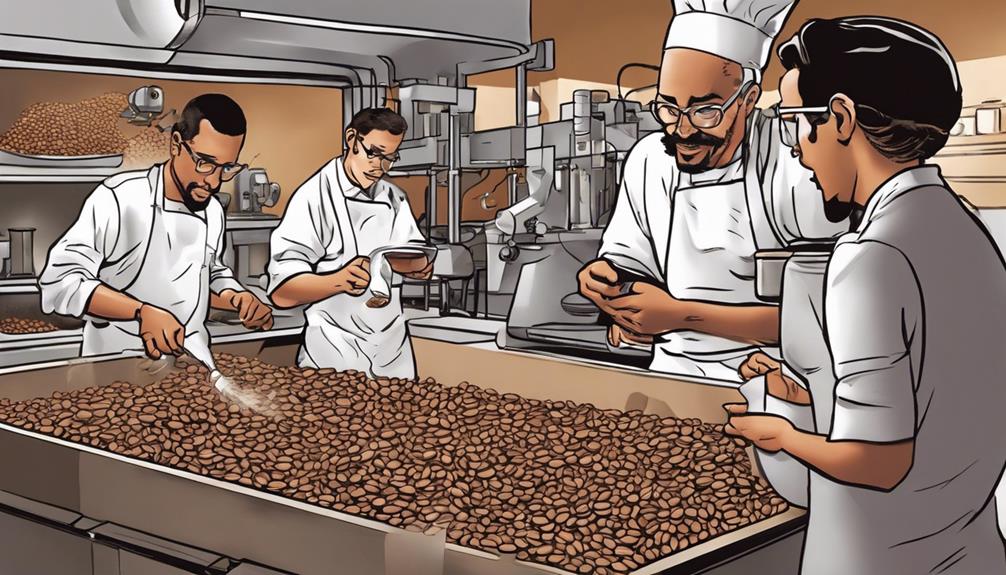
Commercial flavor enhancers are commonly utilized to improve the taste of coffee beans, with methods such as soaking beans in flavoring oils.
When evaluating commercial flavor enhancers for your coffee beans, consider the following:
- Types of Enhancers: Commercial flavor enhancers come in various forms, including flavoring oils and candy flavoring oils. These enhancers are specifically designed to infuse unique and delicious tastes into the beans.
- Soaking Duration: To ensure peak flavor infusion, it's recommended to soak the coffee beans in the flavoring oils for at least 30 minutes. This allows the beans to absorb the flavors effectively, enhancing the overall taste profile.
- Availability for Home Use: While coffee shops often use commercial flavor enhancers, online platforms offer a wide range of these products in different quantities for home use. This accessibility allows coffee enthusiasts to experiment with flavoring their beans at home according to their preferences.
Frequently Asked Questions
How to Add Flavor While Roasting Coffee Beans?
To add flavor while roasting coffee beans, experiment with spices, extracts, or oils. Sprinkle cinnamon or nutmeg, mix in vanilla or almond extract, or drizzle hazelnut or coconut oil before roasting. Find your perfect blend for enhanced taste.
How Do You Intensify Coffee Flavor?
To intensify coffee flavor, experiment with baking times and temperatures. Low heat caramelizes sugars, triggering the Maillard reaction for a richer taste. Short baking durations enhance aroma and create a more complex profile. Enjoy the bold, sweet notes!
How Do You Make Coffee Beans Taste Better?
To make coffee beans taste better, experiment with baking times and temperatures. Roast them at home for rich, complex flavors. Control the process for a personalized coffee experience. Enhance your cup with unique tastes.
What Enhances Coffee Flavor?
Seek the perfect roast: baking coffee beans elevates flavor through the Maillard reaction, caramelizing sugars for rich tastes. Customize with spices for unique profiles. Experiment with temps to reveal a spectrum of boldness.
Conclusion
To sum up, baking coffee beans to enhance their flavor is a simple and effective way to elevate your coffee experience.
Whether you prefer a hint of cinnamon or a touch of vanilla, the possibilities are endless.
Imagine starting your day with a cup of freshly brewed, uniquely flavored coffee that you infused yourself.
So, grab your favorite spices and oils, get creative, and enjoy the delicious results of your flavorful beans!
